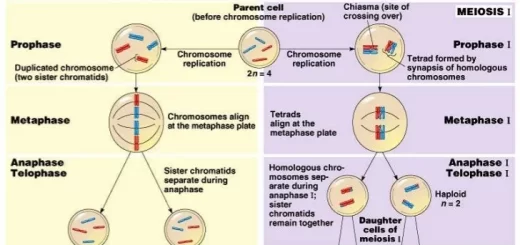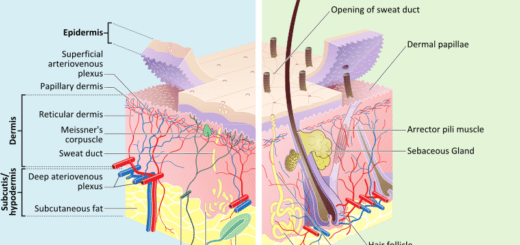Adrenal (suprarenal) glands, Pancreas, Sex glands (Gonads) and Gastrointestinal hormones
Adrenal (suprarenal) glands are two glands, where each one of them is located above one of the two kidneys, Each gland consists anatomically and physiologically of two regions which are: the outer part which is called cortex, the inner part that is called medulla, The hormones that secreted from the cortex differ from those secreted from the medulla.
Hormones of the cortex
The cortex of the adrenal gland secretes a group of hormones that known as steroids which can be divided into three groups as the following:
Glucocorticoids: They include cortisone hormone and corticosterone hormone, They regulate the carbohydrate (sugar-starch) metabolism in the body.
Mineralocorticoids: They include aldosterone hormone that plays an important role in maintaining the mineral balance in the body, as it increases the reabsorption of sodium and excretion of excess potassium through the two kidneys.
Sex hormones: Although the main sources of sex hormones are the testes in male and ovaries in female, there are similar hormones that are secreted from the adrenal gland cortex such as the male sex hormone testosterone and female sex hormones oestrogen and progesterone.
If there is an unbalance in the secretion of adrenal cortex sex hormones and the sex hormones that are secreted from the special glands, it leads to muscularization in females, Feminization in males, Atrophy of gonads in both sexes (if there is a tumor in the cortex of adrenal glands).
Hormones of the medulla
The medulla of the adrenal gland secretes two hormones which are adrenaline and noradrenaline that are known as emergency hormones, They are responsible for the vital activities occurring in the body when an individual is subjected to emergencies such as fear, fight, excitation and during muscular exercises, as they:
- Increase the sugar (glucose) level in the blood that results from the breakdown of glycogen which is stored in the liver into glucose.
- Increase the rate and force of heart contraction.
- Increase blood pressure.
- Enable the muscles to take their demands of energy that is needed for their contraction (as a result of the previous changes) and increase the rate of oxygen consumption.
Pancreas
It is a mixed gland that gathers between the exocrine and endocrine glands where it pours its pancreatic juice (digestive enzymes) that are secreted from the pancreatic acini (glandular cells) through the pancreatic duct into the duodenum (acts as an exocrine gland), It secretes hormones directly into the blood from groups of specialized small glandular cells that are called islets of Langerhans (acts as endocrine gland).
The types of cells in islets of Langerhans
Alpha cells
They are small in number and secrete glucagon hormone, It increases the sugar (glucose) level in the blood by increasing the breakdown of glycogen that is stored in the liver into glucose.
Glycogen → Glucose , (Glucagon hormone)
Beta cells
They represent the majority of islets of Langerhans cells and secrete insulin hormone, It decreases the glucose level in the blood by:
- Stimulating the oxidation and utilization of glucose in the different body tissues and cells to produce energy, where it stimulates the transport of all monosaccharides (except fructose) through the cell membrane to inside the cell to be used (oxidized).
- Controlling the relation between glycogen that is stored in the liver and glucose that is free in the blood, where it stimulates the conversion of glucose into glycogen or lipids to be stored in the liver and muscles or in the other body tissues.
Glucose → Glycogen or lipids , (Insulin hormone)
The decrease in insulin hormone secretion leads to a disease called Diabetes Mellitus that is characterized by a disturbance in the metabolism of carbohydrates (glucose) and lipids.
Symptoms of Diabetes Mellitus disease:
- The increase of glucose level in the blood above the normal level (appears in the analysis of blood and urine).
- Continuous thirst sensation and excessive micturition, as a result of the increase of glucose amount in urine that is associated with the excretion of large amounts of water.
Glucagon hormone antagonizes the action of insulin hormone, Glucagon hormone & insulin hormone are directly related to the level of glucose in the body as they preserve the glucose level constant in the blood which ranges between (80 – 120 milligram / 100 cm³).
Sex glands (Gonads)
The sex glands (gonads) are:
Gonads secrete a group of sex hormones that are responsible for the growth of genital organs and the appearance of secondary sex characters, They are two types which are male sex hormones and female sex hormones.
Male sex hormones
Male sex hormones are called androgens and include two hormones which are Testosterone hormone and Androsterone hormone, They are secreted from the interstitial cells in testis.
Functions:
- The growth of the prostate gland and seminal vesicles.
- The appearance of male secondary sex characters.
Female sex hormones
Female sex hormones are called oestrogens and include three hormones which are:
- Oestrogen (Oestradiol) is secreted from the Graafian follicle of the ovary, It helps in the appearance of female secondary sex characters such as the increase in the size of breasts and regulation of the menstrual cycle.
- Progesterone is secreted from the corpus luteum of the ovary and placenta of the uterus, It is important during pregnancy as it regulates the vascularity of the uterine wall and prepares it to receive the embryo, It is responsible for the changes taking place in the mammary glands during pregnancy.
- Relaxin is secreted from the placenta and uterus, It causes the relaxation of the pubic symphysis at the end of pregnancy to facilitate the process of delivery.
Gastrointestinal hormones
The mucous membrane lining the alimentary canal contains a group of glands that secrete the digestive enzymes, It secretes a group of hormones that stimulate the different parts of the alimentary canal (glands) to secrete the digestive juices such as:
- Gastrin that is secreted from the stomach wall and transferred through the blood to the stomach again to stimulate it to secrete its gastric juice.
- Secretin and cholecystokinin that are secreted from the small intestinal wall and transferred through the blood to the pancreas to stimulate it to secrete its pancreatic juice.
Endocrine system, Endocrine glands, Pituitary gland & Hormonal coordination in living organisms
Thyroid gland, Diseases of thyroid gland & Function of Parathyroid glands
Methods of reproduction in living organisms (Asexual reproduction & Sexual reproduction)



